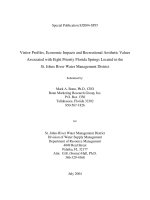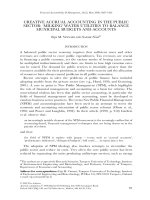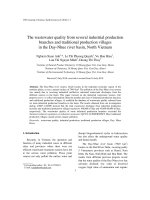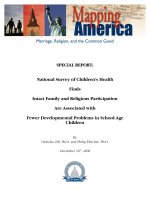Visitor Profiles, Economic Impacts and Recreational Aesthetic Values Associated with Eight Priority Florida Springs Located in the St. Johns River Water Management District pot
Bạn đang xem bản rút gọn của tài liệu. Xem và tải ngay bản đầy đủ của tài liệu tại đây (571.23 KB, 151 trang )
Special Publication SJ2004-SP35
Visitor Profiles, Economic Impacts and Recreational Aesthetic Values
Associated with Eight Priority Florida Springs Located in the
St. Johns River Water Management District
Submitted by:
Mark A. Bonn, Ph.D., CEO
Bonn Marketing Research Group, Inc.
P.O. Box 1356
Tallahassee, Florida 32302
850-567-1826
for
St. Johns River Water Management District
Division of Water Supply Management
Department of Resource Management
4049 Reid Street
Palatka, FL 32177
Attn: G.B. (Sonny) Hall, Ph.D.
386-329-4368
July 2004
i
Table of Contents
ACKNOWLEDGEMENTS………………………………………………………………… i
EXECUTIVE SUMMARY ES-i
CHAPTER 1 1
INTRODUCTION TO THE PRIORITY SPRINGS ECONOMIC ANALYSES FOR
MINIMUM FLOWS AND LEVELS DEVELOPMENT
1.1. Purpose of the Study 1
1.2. An Overview of Priority Spring Attendance 2
1.3. An Overview of the Seasonality of Spring Attendance 4
CHAPTER 2 8
MARION COUNTY, FLORIDA: AN ECONOMIC ANALYSIS OF SILVER GLEN
SPRINGS AND SILVER SPRINGS
2.1. An Economic Profile of Marion County, Florida 8
2.2. Silver Glen Springs 12
2.2.1. Description of Silver Glen Springs 12
2.2.2. Annual and Seasonal Attendance 13
2.2.3. Economic Impact of Visitors from Outside Marion County - Spending,
Wages and Employment Generated Quarterly and Annually 14
2.2.4. Recreational and Aesthetic Use Value 21
2.2.5. Visitor Profile 22
2.3. Silver Springs 22
2.3.1. Description of Silver Springs 22
2.3.2. Annual and Seasonal Attendance 23
2.3.3. Economic Impact of Visitors from Outside the County – Spending, Wages
and Employment Generated by Quarter and Annually 24
2.3.4. Recreational and Aesthetic Use Value 25
2.3.5. Visitor Profile 26
CHAPTER 3 27
LAKE COUNTY, FLORIDA: AN ECONOMIC ANALYSIS OF ALEXANDER SPRINGS,
APOPKA SPRING AND BUGG SPRING
3.1. An Economic Profile of Lake County, Florida 27
3.2. Alexander Springs 31
3.2.1. Description of Springs 31
3.2.2. Annual and Seasonal Attendance: 31
ii
3.2.3. Economic Impact of Visitors from Outside the County – Spending, Wages
and Employment Generated by Quarter and Annually 32
3.2.4. Recreational and Aesthetic Use Value 34
3.2.5. Visitor Profile 35
3.3. Apopka Spring 35
3.3.1. Description of the Spring 35
3.3.2. Annual and Seasonal Attendance 36
3.3.3. Economic Impact of Visitors from Outside Lake County - Spending,
Wages and Employment Generated by Quarter and Annually 36
3.3.4. Recreational and Aesthetic Use of Value 37
3.3.5. Visitor Profile 38
3.4. Bugg Spring 38
3.4.1. Description of Spring 38
3.4.2. Annual and Seasonal Attendance 39
3.4.3. The Economic Impact of Visitors from Outside the County- Spending;
Wages and Employment Generated by Quarter and Annually 39
3.4.4. Recreational and Aesthetic Use Value of Springs 40
3.4.5. Visitor Profile 40
CHAPTER 4 41
VOLUSIA COUNTY, FLORIDA: AN ECONOMIC ANALYSIS OF PONCE DE LEON
SPRINGS, GEMINI SPRINGS, AND GREEN SPRINGS
4.1. Economic Profile of Volusia County, Florida 41
4.2. Ponce de Leon Springs 45
4.2.1. Description of the Springs 45
4.2.2. Annual and Seasonal Attendance 45
4.2.3. Economic Impact of Visitors from Outside the County – Spending, Wages,
and Employment Generated by Quarter and Annually 46
4.2.4. Recreational and Aesthetic Use Value 47
4.2.5. Visitor Profile 48
4.3. Gemini Springs: 48
4.3.1. Description of Springs 48
4.3.2. Annual and Seasonal Attendance 48
4.3.3. Economic Impact of Visitors from Outside the County – Spending; Wages
and Employment Generated by Quarter and Annually: 49
4.3.4. Recreational and Aesthetic Use Value 50
4.3.5. Visitor Profile 50
4.4. Green Springs 51
4.4.1. Description of the Spring 51
4.4.2. Annual and Seasonal Attendance 51
iii
4.4.3. Economic Impact of Visitors from Outside the County – Spending, Wages,
and Employment Generated by Quarter and Annually 51
4.4.4. Recreational and Aesthetic Use Value 52
4.4.5. Visitor Profile 53
CHAPTER 5 54
SUMMARY
REFERENCES……………………………………………………………………………… 59
APPENDICES 60
Appendix A: Quarterly Visitor Economic Impact for Eight Priority Springs 61
Appendix B: Quarterly Visitor Profile……………………………………………………….123
Appendix C: Silver Glen Springs Visitor Profile 129
Appendix D: Silver Springs Visitor Profile 130
Appendix E: Alexander Springs Visitor Profile 131
Appendix F: Apopka Spring Visitor Profile 132
Appendix G: Ponce de Leon Springs Visitor Profile 133
Appendix H: Gemini Springs Visitor Profile 134
Appendix I: Florida Springs Visitor Survey 135
iv
List of Tables
Executive Summary
Table ES-1 A Summary of the Seasonality of Attendance by Quarter for Eight Priority
Springs in Marion, Lake and Volusia Counties, Florida ES-2
Table ES-2 Economic Impact Summary for Eight Priority Springs… …………………. ES-7
Chapters 1-5
Table 1.1 3
Estimated Total Annual Attendance and Visitors from Outside the County for Eight Priority
Springs in Marion; Lake and Volusia Counties, Florida
Table 1.2 6
A Summary of the Seasonality of Attendance by Quarter in Eight Priority Springs in
Marion; Lake and Volusia Counties, Florida
Table 2.1 9
Growth of Selected Economic Indicators for Marion County, Florida Containing Two
Priority Springs, 1990-2001
Table 2.2 11
Socioeconomic Profile of Marion County, Florida Containing Two Priority Springs, 2001
Table 2.3 11
Economic Characteristics of Marion County, Florida Containing Two Priority Springs,
2001
Table 2.4 13
Annual Attendance Estimation for Silver Glen Springs
Table 2.5 16
Estimation of the Direct Economic Impact of Visitors Associated with Silver Glen Springs,
Marion County, Florida 3rd Quarter (July-Sept), 2003
Table 2.6 20
Estimation of Quarterly Spending; Created Employment and Wages at Glen Springs for
Marion County, Florida 3rd Quarter (July-Sept), 2003
Table 2.7 20
Quarterly and Annual Economic Impact of Out of County Visitors to Silver Glen Springs on
Marion County, Florida, 2003-2004
Table 2.8 23
Annual Attendance Estimation for Silver Springs
v
Table 2.9 25
Quarterly and Annual Economic Impact of Out of County Visitors to Silver Springs on
Marion County, Florida, 2003-2004
Table 3.1 28
Growth of Selected Economic Indicators for Lake County, Florida Containing Three
Priority Springs, 1990-2001
Table 3.2 30
Socioeconomic Profile of Lake County, Florida Containing Three Priority Springs, 2001
Table 3.3 30
Economic Characteristics of Lake County, Florida Containing Three Priority Springs,
2001
Table 3.4 32
Annual Attendance Estimation for Silver Glen Springs
Table 3.5 34
Quarterly and Annual Economic Impact of Out of County Visitors to Alexander Springs on
Lake County, Florida, 2003-2004
Table 3.6 35
Use Value for Alexander Springs
Table 3.7 37
Quarterly and Annual Economic Impact of Out of County Visitors to Apopka Spring on
Lake County, Florida, 2003-2004
Table 3.8 38
Use Value for Apopka Spring
Table 3.9 40
Quarterly and Annual Economic Impact of Out of County Visitors to Bugg Spring on Lake
County, Florida, 2003-2004
Table 4.1 42
Growth of Selected Economic Indicators for Volusia County, Florida Containing Three
Priority Springs, 1990-2001
Table 4.2 44
Socioeconomic Profile of Volusia County, Florida Containing Three Priority Springs, 2001
Table 4.3 44
Economic Characteristics of Volusia County, Florida Containing Three Priority Springs,
2001
vi
Table 4.4 45
Annual Attendance Trend 1990-2002, Ponce de Leon Springs
Table 4.4 46
Annual Attendance Estimation for Ponce de Leon Springs
Table 4.5 47
Quarterly and Annual Economic Impact of Out of County Visitors to Ponce de Leon Springs
on Volusia County, Florida, 2003-2004
Table 4.6 49
Annual Attendance Estimation for Gemini Springs
Table 4.7 50
Quarterly and Annual Economic Impact of Out of County Visitors to Gemini Springs on
Volusia County, Florida, 2003-2004
Table 4.8 52
Quarterly and Annual Economic Impact of Out of County Visitors to Green Springs on
Volusia County, Florida, 2003-2004
Table 5.1 56
Total Economic Impact for Eight Priority Springs
Table 5.2 Visitor Spending Component 57
Table 5.3 Overall Springs Visitor Profile 58
i
ACKNOWLEDGEMENTS
The success of any project is dependent upon the cooperation of many individuals. This
particular project involved a number of team players that all worked together in order to
complete this twelve-month study.
Special acknowledgements are extended to the St. Johns River Water Management
District (SJRWMD) personnel. In particular, G.B. (Sonny) Hall, Ph.D., Technical Program
Manager, Division of Water Supply Management, is to be thanked for his vision and
commitment to obtain vital information related to priority natural springs. He is also recognized
for assistance with the project’s report editing tasks along with Chris Ware, Environmental
Scientist, SJRWMD. Carol Miller, Administrative Assistant, SJRWMD, is to be recognized for
her help with administrative details.
Dr. Fred Bell, Professor Emeritus, Department of Economics, Florida State University, is
to be recognized for his efforts related to economic report writing and economic interpretation.
Rhonda Wiggins, President, Marketing Intelligence for Business, is recognized for assistance
with all on-site data collection efforts. Mo Dai, Research Manager, Bonn Marketing Research
Group, Inc. is thanked for her assistance with project data management, manuscript preparation,
and many other tasks.
Finally, appreciation is extended to all of those county, state and federal government
representatives providing invaluable information necessary for the completion of this study.
Mark A. Bonn, Ph.D.
President
Bonn Marketing Research Group, Inc.
ES-1
EXECUTIVE SUMMARY
Purpose of the Study
The purpose of this research project was to establish a present baseline of knowledge
pertaining to visitor characteristics including their economic impacts and associated recreational
values for eight priority springs in the St. Johns River Water Management District (SJRWMD).
Priority springs by definition are those springs prioritized by SJRWMD for the establishment of
minimum flows and levels in accordance with Chapter 373, Florida Statutes. These springs by
county include:
Marion County:
1. Silver Glen Springs
2. Silver Springs
Lake County:
3. Alexander Springs
4. Apopka Spring
5. Bugg Spring
Volusia County:
6. Ponce de Leon Springs
7. Gemini Springs
8. Green Springs
This research project included on-site data collection, editing, collation, entry, and
various statistical and economic analyses over a twelve-month period of time for the eight
selected priority springs. A total of 2,298 usable surveys were obtained to meet the objectives of
this study. This allowed for overall statistical reporting at the 95% level of confidence with +/-
5% error.
During the twelve months of on-site data collection, it became obvious that seasonality
was a key issue related to springs usage patterns. Table ES-1 identifies the seasonality of
attendance by quarter for the priority springs.
ES-2
Table ES-1
A Summary of the Seasonality of Attendance by Quarter in Eight Priority Springs in
Marion, Lake and Volusia Counties, Florida
Springs
First
(Jan-Mar)
Second
(Apr-June)
Third
(July-Sept)
Fourth
(Oct-Dec)
Annual
%
Source of
Data
Marion County
1.
Silver Glen Springs 7% 44% 43% 6% 100% USFS*
2.
Silver Springs 25 28 27 20 100 Shifflet**
Lake County
3.
Alexander Springs
Day Visitors 15 41 37 7 100 USFS*
Camper Visitors 31 31 17 21 100 USFS*
4.
Apopka Spring 15 41 37 7 100 Alex****
5.
Bugg Spring 15 41 37 7 100 Alex****
Volusia County
6.
Ponce de Leon Springs 21 33 34 12 100 Florida***
7.
Gemini Springs 20 40 24 16 100
Volusia
County*****
8.
Green Springs 20 40 24 16 100
Volusia
County*****
Average 19% 38% 31% 12% 100%
* U.S. Forest Service Data, 1998-2002;
** Shifflet and Associates for Central Region of Florida (2002);
*** Florida Park Service, 1990-2002;
**** Alexander Springs Seasonality in Lake County is used for Apopka Spring and Bugg Spring in same county;
***** Gemini Springs Seasonality in Volusia County is used for Green Springs in same county.
FINDINGS
Silver Glen Springs
Average party size: 3.5 (74% non-county residents)
Average nights spent: 1.6
Daily expenditures per party: $44.31
Willingness to pay for access to private springs: $4.17
Percent using commercial lodging properties
1
: 3%
First visit to springs? 21.5%
Annual economic impact: $348,770.00
Wages created: $66,370.00
Employment created: 5.63 full/part time jobs
1
Commercial lodging properties include hotels/motels, campgrounds and RV parks.
ES-3
Silver Springs
Average party size: 3.0 (percent of non-county residents unavailable)
Average nights spent: 2.3
Daily expenditures per party: $248.60
Willingness to pay for access to private springs: N/A
Percent using commercial lodging properties: N/A
First visit to springs? N/A
Annual economic impact: $61,450,000.00
Wages created: $12,610,000.00
Employment created: 1,060.5 full/part time jobs
Alexander Springs
Average party size: 3.7 (54% non-county residents)
Average nights spent: 1.2
Daily expenditures per party: $43.85
Willingness to pay for access to private springs: $4.57
Percent using commercial lodging properties: 29.3%
First visit to springs? 20.0%
Annual economic impact: $775,520.00
Wages created: $170,240.00
Employment created: 13.6 full/part time jobs
Apopka Spring
Average party size: 3.3 (67% non-county residents)
Average nights spent: 1.3
Daily expenditures per party: $22.21
Willingness to pay for access to private springs: $4.50
Percent using commercial lodging properties: 23.4%
First visit to springs? 34.3%
Annual economic impact: $28,520.00
Wages created: $5,940.00
ES-4
Employment created: 0.52 full/part time jobs
Bugg Spring
Average party size: N/A
Average nights spent: N/A
Daily expenditures per party: N/A
Willingness to pay for access to private springs: N/A
Percent using commercial lodging properties: N/A
First visit to springs? N/A
Annual economic impact: $11,660.00
Wages created: $2,420.00
Employment created: 0.21 full/part time jobs
Ponce de Leon Springs
Average party size: 3.7 (62% non-county residents)
Average nights spent: 1.1
Daily expenditures per party: $43.50
Willingness to pay for access to private springs: $4.95
Percent using commercial lodging properties: 14.0%
First visit to springs? 43.8%
Annual economic impact: $2,185,440.00
Wages created: $425,600.00
Employment created: 36.11 full/part time jobs
Gemini Springs
Average party size: 3.9 (51% non-county residents)
Average nights spent: 1.2
Daily expenditures per party: $34.10
Willingness to pay for access to private springs: $4.67
Percent using commercial lodging properties: 5.8%
First visit to springs? 17.8%
Annual economic impact: $322,870.00
ES-5
Wages created: $68,910.00
Employment created: 6.26 full/part time jobs
Green Springs
Average party size: N/A
Average nights spent: N/A
Daily expenditures per party: N/A
Willingness to pay for access to private springs: N/A
Percent using commercial lodging properties: N/A
First visit to springs? N/A
Annual economic impact: $81,550.00
Wages created: $16,870.00
Employment created: 1.53 full/part time jobs
Overall findings for the eight priority springs indicated that total annual direct spending
by visitors accounted for over $65 million, generated over $13 million in wages, and
created over 1,100 jobs. Silver Springs, which has a large theme park associated with the
natural springs environment, accounted for 94% of the total economic impact to the
region, while the remainder of the springs contributed only 6% (Table ES-2).
Table ES-2 Economic Impact Summary for Eight Springs
Springs Direct Spending
% Wages % Employment
%
Silver Glen
$348,770.00
0.53%
$66,370.00
0.50%
5.63
0.50%
Silver
$61,450,000.00
94.24%
$12,610,000.00
94.34%
1,060.50
94.32%
Alexander
$775,520.00
1.19%
$170,240.00
1.27%
13.60
1.21%
Apopka
$28,520.00
0.04%
$5,940.00
0.04%
0.52
0.05%
Bugg
$11,660.00
0.02%
$2,420.00
0.02%
0.21
0.02%
Ponce de Leon
$2,185,440.00
3.35%
$425,600.00
3.18%
36.11
3.21%
Gemini
$322,870.00
0.50%
$68,910.00
0.52%
6.26
0.56%
Green
$81,550.00
0.13%
$16,870.00
0.13%
1.53
0.14%
Total $65,204,330.00
100.00%
$13,366,350.00
100.00%
1,124.36
100.00%
1
CHAPTER 1
INTRODUCTION TO THE PRIORITY SPRINGS ECONOMIC ANALYSES FOR
MINIMUM FLOWS AND LEVELS DEVELOPMENT
1.1. Purpose of the Study
The purpose of this Chapter is to introduce to the reader the economic impacts and
recreational and aesthetic values associated with eight priority springs in the St. John River
Water Management District (SJRWMD). By State of Florida law, SJRWMD must establish
minimum flows and levels (MFLs) necessary to prevent significant ecological damage or harm
to both permitted consumptive and non-consumptive uses such as navigation, recreation, fish and
wildlife habitat and other natural resources. MFLs designate hydrological conditions that
identify which water is available for reasonable beneficial use. If not set properly, these MFLs
can also impair and harm economic activity connected with aquatic communities such as
wetlands, streams and lakes, and springs for which Florida is famous with residents and visitors.
An important objective of this research is to establish a data-base containing information, such as
values, socioeconomic and associated market characteristics, etc., that surround the eight priority
springs for which SJRWMD is developing MFLs.
The main objective of this research is to establish a present economic baseline including
economic impacts and recreational values for eight priority springs in SJRWMD. These springs
by county are:
Marion County:
Silver Glen Springs
Silver Springs
Lake County:
Alexander Springs
Apopka Spring
Bugg Spring
Volusia County:
Ponce de Leon Springs
Gemini Springs
Green Springs
2
The St. Johns River Water Management District selected the Bonn Marketing Research
Group, Inc. (BMRG) to complete this study of eight priority springs because of BMRG’s well
established expertise in marketing research, economics and statistical applications applied to
natural springs resources, tourism and recreation. Prior to the initiation of this project, BMRG
recently completed several similar regional research projects for Florida water management
districts that addressed many similar issues related to Florida springs visitors including their
psychological characteristics and associated economic value attributed to their springs-related
spending (Bonn & Bell, 2003). These eight priority springs addressed in this study range from
highly developed, well attended springs to those in the development stage with little or presently
no appreciable attendance.
The work designated by the contract included randomized day/site/time data collection,
editing, collation, entry, and various statistical and economic analyses to present an assessment
and summary of the economic impacts and recreational and aesthetic values for eight priority
priority springs. Priority springs by definition are those springs prioritized by SJRWMD for the
establishment of minimum flows and levels in accordance with Chapter 373, Florida Statutes.
1.2. An Overview of Priority Spring Attendance
Table 1.1 shows a summary of some fundamental economic variables that we have
gathered in our research for each of the eight priority springs. We have included estimated
annual attendance; days per attendee; percent of total visitors from outside the county; the
number of annual visitors from outside the county; the source/managing the particular spring and
last year for which attendance was available given the time constraints of this contract. The
source of such data in Table 1.1 varies considerably as does the quality of such data. Total
attendance at all eight counties is a little over 1.5 million persons ranging from 2,900 visitors to
Bugg Spring in Lake County to over one million persons visiting Silver Springs in Marion
County (Table 1.1). These springs are managed/controlled by various state, federal, and private
entities. For example, Ponce de Leon in Volusia County is managed and owned by the State of
Florida. Silver Glen and Alexander Springs in Marion and Lake Counties respectively are owned
and managed by the U.S. Forest Service. Gemini Springs and Green Springs are managed and
owned by Volusia County. Finally, Silver Springs and Bugg Spring are privately controlled.
Some springs are fully developed, such as Ponce de Leon, while others, such as Green Springs in
3
Volusia County, are under development by the county. Bugg Spring in Lake County is still held
by private owners and or government entities (e.g., Federal government) that place this spring in
a category of “developing.” Thus, there is great diversity in ownership and stage of development
for the eight priority springs listed in Table 1.1.
Table 1.1
Estimated Total Annual Attendance and Visitors from Outside the County for Eight Priority Springs in
Marion, Lake and Volusia Counties, Florida
Annual
Attendance
(Person Days)
Days Per
Attendee
Percent
from
Outside
County*
Estimated
Number of
Visitor to
County
Springs
Managed by
Year for
Data
Marion County
1. Silver Glen Springs 39,235 One 70% 27,471 USFS** 2002
2. Silver Springs 1,096,000 One 70% 767,200 Private 2003
Lake County
3. Alexander Springs
Day 55,819 One 68% 37,957 USFS** 2002
Camping 21,414 Two 68% 14,562 USFS** 2002
4. Apopka Spring 5,776***
One 70% 4,064 Florida****
2003
5. Bugg Spring 2,888***
One 61% 1,756 Private 2002
Volusia County
6. Ponce de Leon 259,000 One 72% 186,480 Florida****
2002
7. Gemini 57,755 One 64% 36,964
Volusia
County
2002
8. Green 14,439***
One 64% 9,241
Volusia
County
2002
Total
1,529,223 1,085,695
* Percentage of Total Attendance Living Outside the County from On-Site Survey
** Data Obtained from the United States Forest Service on Attendance.
*** Official attendance figures are not available for Apopka, Bugg and Green springs. However, the potential
attendance figures could be estimated by using Gemini attendance figures by Volusia County. The following
conversion factors were applied:
Green Springs: 25% of Gemini
Apopka Spring: 10% of Gemini
Bugg Spring: 5% of Gemini
**** The State of Florida owns Apopka Spring, but does not collect attendance data since it is not well developed. Of
the 8 springs, the State of Florida runs only Ponce de Leon as an operating springs park.
4
Attendance at the priority springs is, in most cases, measured on a daily basis since the
springs are closed for the night. Thus, the annual attendance shown in Table 1.1 is also the
number of person days for the entire year with one exception, attendees who camp overnight at
Alexander Springs, Lake County. Forest Service personnel indicate that campers usually stay in
the campgrounds for at least 2 days. Person days are estimated by multiplying by 2. This will
become important later in the economic analysis because spending is estimated through surveys
on a per party day basis. More will be said about the economics procedure used to calculate the
impact of spending by those attending the priority springs.
As indicated in Table 1.1, approximately two-thirds of those attending the priority springs
come from outside the county in which the spring is located. This percentage is generally the
same from spring to spring. Therefore, we see that of the over 1.5 million spring attendees, over
1 million are not residents of the county in which the spring is located. From an economic
impact point of view, visitors from outside a region or county infuse money spent during their
visit into the local economy that reverberates through that county in a multiplier fashion. A
dollar spent by visitors equates to a $1.30 - $1.80 impact upon the local economy and is,
therefore, an important contribution to the economic base of each county. The economic base of
each county is rooted in those industries and visitor facilities that draw money into the local
economy. In addition, resident spending is stimulated by the availability of the spring(s) in their
county. This is addressed in the following chapters where the economic impact for all springs
specific to this study are addressed
The reader should be aware that this project stretched from 2003 to 2004. We were able
to get some data earlier than other data on attendance. At the point of contact (i.e., researcher to
the U.S. Forest Service), the most recent annual data were either 2002 or 2003. It will make little
difference which of the most recent years is used because of the fluctuation in attendance from
year to year.
1.3. An Overview of the Seasonality of Spring Attendance
In developing MFLs for springs, it is important to recognize that hydrological events vary
greatly within the year. Rainfall in Florida varies considerably depending on the region of the
state. For example, precipitation in Jacksonville in 2001 was 0.6 inches in April and 16 inches in
September (Florida Statistical Abstract). Such rainfall variation is not always the same from
5
year to year, but there is a noticeable seasonality in environmental variables. In many cases,
variations in environmental variables, such as temperature and rainfall, are the causal factors
behind variations in economic measures. Because of the interaction between environmental
variables and economic behavior during the year, we developed seasonal indices of economic
behavior.
Table 1.2 shows the estimated percent of annual attendance by quarter to provide the
economic seasonality of attendance at springs. In most cases, the source of the data is from the
same source that we used to obtain annual data (Table 1.1). We requested data from these
sources on a monthly basis for several years, when possible, in order to establish the seasonality
of priority springs attendance. Data records varied from source to source. For example, monthly
attendance data for Ponce de Leon Spring were obtained from 1990-2002. The U.S. Forest
Service only had attendance data going back to 1998. Gemini Springs in Volusia County has
had only a few years to establish seasonal patterns. For some springs we used nearby springs as
proxies for the springs in question because of lack of data. For example, the seasonality of
Apopka and Bugg Spring was approximated by data obtained for Alexander Springs run by the
U.S. Park Service and the seasonality of Green Springs was establish by using the data set we
generated for Gemini Springs in Volusia County. Finally, the privately owned Silver Springs in
Ocala did not provide any attendance data, but our analysis indicates that it is a theme park
facility (e.g., Disney) that would exemplify the seasonality in tourism to Central Florida
formulated by Shifflet (2002). In all cases, we contacted the officials involved with running or
developing the springs to confirm that they were in agreement with our attendance projections.
The data show that strong attendance seasonality exists at the priority springs (Table 1.2).
The non-weighted average of attendance at the priority springs indicates that 60 – 70% of the
annual attendance occurs during the spring and summer (second and third quarters, Table 1.2).
Weather probably plays a role in this distribution. Interesting attendance patterns are displayed
by Alexander Springs in Lake County, the only spring analyzed that has camping facilities, and
Silver Springs in Marion County, the only theme park facility. Day visitors to Alexander
Springs show a seasonal pattern similar to the other priority springs. However, campers show a
concentration in the winter and spring quarters presumably because in-state campers are avoiding
the periods of extreme summer heat in Florida and out-of-state visitors are coming south during
the winter months to enjoy the less extreme winter conditions experienced in Florida. Silver
6
Springs is estimated to have a more even attendance pattern because it is a theme park facility
and should follow typical Florida attractions visitation patterns.
Table 1.2
A Summary of the Seasonality of Attendance by Quarter in Eight Priority Springs in
Marion, Lake and Volusia Counties, Florida
Springs
First
(Jan-Mar)
Second
(Apr-June)
Third
(July-Sept)
Fourth
(Oct-Dec)
Annual
%
Source of
Data
Marion County
1.
Silver Glen Springs 7% 44% 43% 6% 100% USFS*
2.
Silver Springs 25 28 27 20 100 Shifflet**
Lake County
3.
Alexander Springs
Day Visitors 15 41 37 7 100 USFS*
Camper Visitors 31 31 17 21 100 USFS*
4.
Apopka Spring 15 41 37 7 100 Alex****
5.
Bugg Spring 15 41 37 7 100 Alex****
Volusia County
6.
Ponce de Leon Springs 21 33 34 12 100 Florida***
7.
Gemini Springs 20 40 24 16 100
Volusia
County*****
8.
Green Springs 20 40 24 16 100
Volusia
County*****
Average 19% 38% 31% 12% 100%
* U.S. Forest Service Data, 1998-2002;
** Shifflet and Associates for Central Region of Florida (2002);
*** Florida Park Service, 1990-2002;
**** Alexander Springs Seasonality in Lake County is used for Apopka Spring and Bugg Spring in same county;
***** Gemini Springs Seasonality in Volusia County is used for Green Springs in same county.
The priority springs were sampled on a quarterly basis in order to better understand
seasonality of attendance and issues related to seasonal patterns of spending, wages, and
employment associated with the priority springs. In our analysis, we address economic impacts
associated with priority springs in three counties: Lake, Marion, and Volusia. The following
report chapters (2-4) provide a brief description of each spring and summarize:
7
• Economic trends and the level of economic activity in that county;
• Annual and seasonal attendance;
• The economic impact of the springs upon the county measured in spending;
• Wages and employment both seasonally and annually; and
• The economic value of recreational and aesthetic uses of the spring resources.
This general outline will be used throughout our economic analysis or baseline economic
data for all eight priority springs. Chapter 5 will summarize the recreational value of the springs
along with the springs’ visitor profiles.
8
CHAPTER 2
MARION COUNTY, FLORIDA: AN ECONOMIC ANALYSIS OF
SILVER GLEN SPRINGS AND SILVER SPRINGS
2.1. An Economic Profile of Marion County, Florida
Marion County is located in north central Florida. This county contains two priority
springs; Silver Glen Springs, located in the Ocala National Forest in the southern part of the
county, and Silver Springs, located in and around the city of Ocala. These two priority springs
draw approximately three-quarters of a million visitors from outside the county annually (Table
1.1). Residents of Marion County comprise an estimated 30% of attendance or demand. Thus,
the county economics is important in determining part of the demand for both priority springs.
Since estimating the demand for these springs is part of the scope for this study, an economic
profile for Marion County can be developed that may have a bearing on spring attendance.
Table 2.1 shows growth trends according to major economic indicators for Marion
County during the period 1990-2001 (U.S. Bureau of Economic Analysis, 2003). In terms of the
population growth rate, Marion County has increased by nearly 36% during this period,
compared to a 26% increase for the State of Florida. In 2001, 0.26 million people resided in
Marion County. Of significance, aggregate personal income grew at a faster rate than that of the
State. The growth in personal income greatly exceeded that of population growth leading to a
rise in per capita income of 44.1% for the period 1990-2001. Even though population and
income growth rates exceeded that of the state, Marion County’s per capita income growth of
44.1 % was below the State of Florida rise of nearly 47%. This indicates that Marion County is
adding industries to its economic base that rival those added by the State. The 34.4% increase in
employment in Marion County indicates that the county is adding slightly more labor-intensive
jobs than the State of Florida, where wage and salary job growth increased by 31.9% over the
period 1990-2001. In most cases, labor-intensive jobs (e.g., restaurants; amusements; health
care) do not increase earnings as fast as capital-intensive jobs. Marion County has a greater
concentration of employees in agriculture, healthcare, social assistance, and low skilled
manufacturing than the State of Florida. Its three major employers are Emergency One, Inc.,
Closet Maid, and Singular Wireless who employ nearly 3,300 persons. Thus, earnings per job in
9
Marion County tend to be below the state average and are just keeping up with the state in terms
of growth (Table 2.1).
Table 2.1
Growth of Selected Economic Indicators for Marion County, Florida
Containing Two Priority Springs, 1990-2001
Economic Indicators 1990 2001
% Change
Rank of Marion County
among 67 Counties in
Florida (2001)
Population Growth
Marion County 194,833 264,277 35.6 18
Florida 12,938,071 16,331,739 26.2 N/A
Aggregate Personal Income
Marion City (Thous $) $ 3,071,486 $ 6,003,254 95.5 19
Florida (Thous $) $ 258,479,049 $ 467,188,758 80.7 N/A
Per Capita Income Growth
Marion County ($) $ 15,765 $ 22,716 44.1 34
Florida ($) $ 19,832 $ 29,048 46.5 N/A
Wage & Salary Job Growth
Marion County 66,519 89,410 34.4 20
Florida 5,802,287 7,655,940 31.9 N/A
Average Earnings per Job
Marion County ($) $ 18,571 26,261 41.4 40
Florida ($) $ 22,879 32,643 42.7 N/A
Source: Regional Economic Information System, U.S. Bureau of Economic Analysis, CD Rom-2003.
Marion County has been able to attract visitors from out of state despite not having any
accommodations tax as a potential tourism revenue source. This is due largely to the fact that
Interstate 75 provides for easy ingress and egress for visitors passing through the area on their
way to popular Florida destinations. In 2002, out of state domestic visitors (U.S.) to Marion
County were 1.1% of all the visitors to the State of Florida that was slightly under 70 million
(Visit Florida, 2004, personal correspondence). Thus, three-quarters of a million domestic
persons visited Marion County, with some stopping at the priority springs. Neither Canadians
10
nor overseas visitors are included in these numbers. Jobs in the visitor industry tend to represent
low paying hourly positions. The skill demands are not great and there is a great deal of
seasonal, of part-time work that generates relatively less earning per year. It would appear from
Table 2.1 that Marion County is exceeding or paralleling the growth rate for many economic
indicators when compared to the State of Florida. However, the county has failed to achieve
parity for both personal per capita income and earnings per job. More will be said on this below.
In Table 2.2, we see a socioeconomic profile of Marion County. Such a profile may be
useful in judging spring attendance figures in terms of those local residence using priority
springs. In 2001, Marion County had a somewhat comparable unemployment rate to the state of
less than 5%. Marion County had a lower participation rate or percent of the population that
were gainfully employed (Marion at 64.3% compared to 73.9 % for the State). This condition
appears where the population is of advanced age and/or there is a lot of disguised unemployment
(i.e., people that wish to work, but because jobs are so scarce, they leave the labor force). The
poverty rate was slightly higher than that for the state reflected in part by the relatively lower
paying jobs in the county. Table 2.2 shows that the median age in Marion County is about 5
years above the state, which is consistent with lower labor force participation and relatively low
per capita income. Attendance at priority springs may be higher or lower depending on the kinds
of recreation offered. Silver Glen Springs probably has more of an appeal to younger people
with its raw terrain. Silver Springs, which is more of a theme park, might appeal to an older
consumer. This county has a higher percentage of white population than exists statewide.
Marion County has nearly 25% of its population over 65 years of age compared to the state
average of nearly 18%. This reinforces our observations that Marion County is, in part, a
retirement community. This county is ranked 14
th
in the state in terms of median age.
Additionally, we prepared a detailed comparison of the components of per capita income
comparing Marion County to the State of Florida (Table 2.3). Because of the relatively low
paying industrial base, dependence on tourism, and age structure of the population, Marion
County has a per capita income over $6,000 below that of the State of Florida. Nearly 88% of
this difference is due to low earnings per person in the county (Table 2.3).









